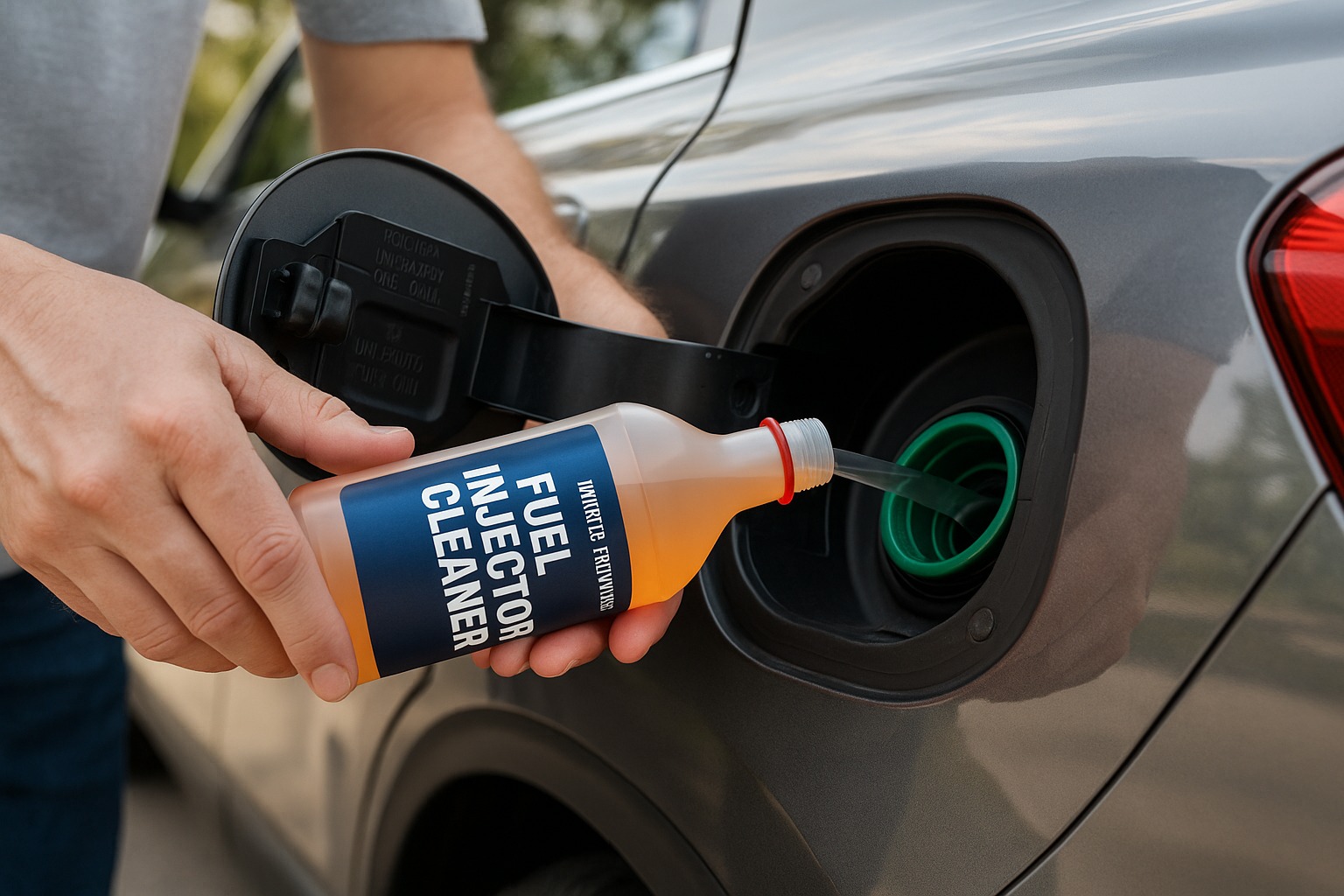If you’ve ever noticed your car running rough, losing power, or guzzling more fuel than usual, there’s a good chance the problem lies in the fuel injectors. These small but critical parts spray fuel into the engine in a fine mist, making sure combustion is clean and efficient. When they get dirty with carbon buildup, varnish, or deposits from low-quality fuel, your car’s performance can quickly take a hit.
That’s where a fuel injector cleaner comes in. This is a specially formulated liquid additive you pour into your fuel tank. Once mixed with the fuel, it travels through the system, breaking down carbon deposits and cleaning the injectors, intake valves, and sometimes even the combustion chamber.
Using fuel injector cleaner the right way has several benefits: smoother idling, better acceleration, restored fuel economy, lower emissions, and in many cases, a longer engine life. Think of it as preventive medicine for your car — small, affordable, and effective if used correctly.
In this guide, I’ll walk you through everything you need to know: how to use fuel injector cleaner, how much to add, how often it’s necessary, expert tips for getting the best results, and even how to choose the right product for your vehicle. By the end, you’ll have a clear step-by-step understanding, just like a technician would explain it in the shop.
- Understanding Fuel Injectors & Why Cleaning Helps
- Types Of Fuel Injector Cleaners & How They Work
- Choosing The Right Fuel Injector Cleaner For Your Vehicle
- How To Use Fuel Injector Cleaner: Step-By-Step Guide
- How Much Fuel Injector Cleaner To Use (Dosage & Frequency)
- Special Cases & Expert-Level Tips
- When A Professional Cleaning Might Be Needed
- Common Myths & Misconceptions (And The Reality)
- Conclusion
Understanding Fuel Injectors & Why Cleaning Helps
What A Fuel Injector Does
Fuel injectors are precision-engineered nozzles that spray fuel directly into the engine’s intake manifold or combustion chamber. Their job is to deliver the exact amount of fuel in a fine mist, timed perfectly with the engine’s air intake. This balance ensures efficient combustion, smooth performance, and clean emissions. In short: no clean injectors, no smooth ride.
What Causes Deposits
Over time, fuel injectors face buildup from several sources:
- Carbon deposits form when fuel doesn’t burn completely.
- Varnish from evaporated fuel leaves sticky residue inside the injector tips.
- Ethanol blends (common in pump fuel) attract moisture, which can leave behind deposits and even corrosion.
- Low-quality fuel often lacks strong detergents, allowing dirt and additives to settle in the injectors.
- Stop-and-go traffic or short trips prevent the engine from fully warming up, making deposits more likely.
- Cold starts in winter also lead to incomplete combustion, adding to buildup.
Symptoms Of Dirty Injectors
When injectors are clogged or restricted, the engine tells you in several ways:
- Rough idle or shaking at stoplights.
- Loss of power during acceleration or uphill driving.
- Hard starting or longer cranking time.
- Decreased fuel economy — you’ll notice more frequent stops at the gas station.
- Misfires and hesitation, especially at low speeds.
These are common complaints that many drivers bring to workshops, and in many cases, the solution is as simple as proper injector cleaning.
Risks Of Ignoring Cleaning
If dirty injectors are left untreated, the problems don’t just stay annoying — they get expensive:
- Increased emissions, possibly causing failed inspection tests.
- Overworked engine components like spark plugs, oxygen sensors, and catalytic converters.
- Higher repair costs in the long run, since clogged injectors can mimic bigger issues and strain the fuel pump.
- Engine damage in extreme cases where lean fuel mixtures cause overheating or detonation.
This is why regular cleaning with a proper injector cleaner isn’t just maintenance — it’s a way to save yourself from future headaches and costly repairs.
Types Of Fuel Injector Cleaners & How They Work
Liquid Fuel-Additive Cleaners (Pour Into Tank)
This is the most common type, and the one you’ll find at any auto parts store. You simply pour the cleaner into your fuel tank, and as you drive, it circulates through the injectors and fuel system. These cleaners rely on chemical detergents, especially PEA (polyetheramine), which is proven to dissolve carbon buildup effectively. They’re safe for regular use, affordable, and easy for any driver to apply.
Spray-On Or Throttle-Body Cleaners
These products are designed for the intake system rather than the fuel tank. Mechanics spray them directly into the throttle body or intake while the engine is running. They’re useful for cleaning intake valves and the air pathway, but they require more care since improper use can cause rough running or even stalling.
Professional / Shop-Based Cleaning Methods
Sometimes, store-bought cleaners aren’t enough. At workshops, technicians use specialized equipment:
- Pressurized canister systems that run cleaner directly through the fuel rail.
- Ultrasonic cleaning where injectors are removed, placed in a machine, and cleaned with high-frequency sound waves that shake loose stubborn deposits.
These methods are more thorough but also more expensive.
Key Active Ingredients And Their Effectiveness
Not all cleaners are created equal. Here’s what matters:
- PEA (Polyetheramine): The gold standard. Strong enough to dissolve carbon and safe for sensors. Look for it in brands like Techron or Lucas.
- PIBA (Polyisobutylamine): Good for preventing deposits, but less powerful at removing heavy buildup.
- Solvents/Alcohols: Sometimes included to thin deposits, but on their own they aren’t very effective.
In short: when shopping, check the label. A good fuel injector cleaner should contain PEA, especially if your car uses direct injection, where deposits tend to be more stubborn.
Choosing The Right Fuel Injector Cleaner For Your Vehicle
Compatibility: Gasoline Vs Diesel, Direct Vs Port Injection
Not all injector cleaners are universal. Some are formulated specifically for gasoline engines, while others are made for diesel systems, which face different deposit issues. Always check the label. If you have a direct injection engine (GDI), pick a cleaner that specifically mentions GDI compatibility since these engines are more prone to heavy carbon buildup compared to older port injection systems.
Brand Reputations & Safety
In the market, certain brands stand out because they’ve been tested by both mechanics and everyday drivers. Techron, Lucas, Sea Foam, and Gumout are trusted names. They contain proven detergents and are widely recommended in workshops. Be cautious with unknown or “budget” products that make big claims without ingredient transparency.
Concentration & Formulation
Some products are designed as one-shot treatments for a single tank, while others are maintenance formulas meant for smaller doses more often. Stronger cleaners usually contain higher concentrations of PEA, which is excellent for restoring clogged injectors. Lighter blends are good for keeping injectors clean if used regularly. Choose based on whether you’re fixing a problem or just maintaining your system.
Certifications & Warnings
Look for cleaners that:
- Are EPA-approved and meet fuel additive safety standards.
- Carry OEM approvals or recommendations. Some automakers mention specific brands in their manuals.
- Clearly state that they’re safe for oxygen sensors and catalytic converters.
Avoid products that contain high levels of unlisted solvents or alcohols. These may thin deposits slightly but can also cause premature wear on seals and damage sensitive components over time.
How To Use Fuel Injector Cleaner: Step-By-Step Guide
Preparation
Before you grab the bottle, a little prep goes a long way:
- Check your owner’s manual: Some automakers recommend or caution against certain additives. Always follow the manual first.
- Read the cleaner’s instructions: Dosage can vary by brand and bottle size.
- Tank level: Most products work best when poured into a nearly empty tank, then filled with fresh fuel. This ensures the cleaner mixes evenly.
- Safety first: Work in a ventilated area and handle the cleaner carefully. The chemicals are strong, so avoid skin or eye contact.
Adding The Cleaner
- Open your fuel cap as if you’re about to refuel.
- Pour the recommended amount of cleaner directly into the tank. Most bottles are designed with a spout for easy pouring.
- Fill the tank with fresh fuel right after adding the cleaner. The incoming fuel helps mix the solution evenly and prevents it from settling at the bottom.
Running The Engine & Driving Conditions
Once the cleaner is in the system, driving style matters:
- Drive soon after filling to make sure the cleaner circulates quickly.
- Highway driving is ideal — steady speeds at moderate RPM allow the cleaner to work through the injectors without frequent stops.
- Avoid extended idling because it won’t push the cleaner effectively through the system.
Monitoring & Evaluating Results
After treatment, you may notice improvements gradually, not instantly:
- A smoother idle and quicker throttle response.
- Better mileage after a full tank is burned through.
- Easier cold starts and reduced hesitation.
If symptoms persist after one treatment, a second round or professional cleaning may be necessary.
How Much Fuel Injector Cleaner To Use (Dosage & Frequency)
General Dosage Guidelines
Most fuel injector cleaners are designed for one bottle per full tank of gas — usually 12 to 20 gallons. The label will always specify the exact tank size it covers. Using the right amount ensures the chemical concentration is strong enough to clean, but not so strong that it causes harm.
Adjusting By Tank Size & Cleaner Strength
- If your vehicle has a smaller tank (for example, a compact car with 10 gallons), you may only need part of the bottle.
- For larger tanks (SUVs or trucks), you might need more than one bottle. Some brands sell concentrated formulas meant for bigger vehicles.
- High-strength cleaners (with high PEA content) usually require less frequent use but may come in smaller bottles. Always follow the dosage chart on the packaging.
How Often To Use Fuel Injector Cleaner
- For regular maintenance, most experts recommend using a cleaner every 3,000 to 5,000 miles, which is roughly every oil change.
- If you often use low-quality fuel, do frequent short trips, or drive mostly in heavy traffic, you might benefit from more regular treatments — for example, every 2,000–3,000 miles.
- Drivers who fill up with premium fuel (which already contains detergents) may need it less often, perhaps every 7,000–10,000 miles.
Risks Of Overuse
More isn’t always better. Adding cleaner too often or using excessive amounts can:
- Dilute the fuel mixture, affecting combustion.
- Put unnecessary strain on oxygen sensors and catalytic converters.
- Waste money without improving results.
Think of injector cleaner like vitamins: the right dose helps, but taking too much won’t make the benefits double — and might even cause problems.
Special Cases & Expert-Level Tips
Using Lucas Fuel Injector Cleaner (And Other Popular Brands)
Some brands, like Lucas, have earned a reputation in workshops for being reliable. Lucas Fuel Injector Cleaner comes in larger bottles, often designed for multiple tanks. Mechanics like it because it’s safe for sensors and doesn’t contain harsh solvents. The key is dosage — follow the label closely. Lucas is strong enough that many drivers use it every few thousand miles as maintenance, not every fill-up.
Direct Injection Vs Port Injection Engines
- Port injection engines spray fuel before the intake valves, so the cleaner can wash across valves as well as injectors.
- Direct injection engines (GDI) spray fuel straight into the combustion chamber. This means the cleaner mainly works on injectors, not intake valves (since fuel bypasses them). GDI engines are prone to heavy valve deposits, which sometimes require professional walnut blasting or intake cleaning in addition to injector cleaner.
High-Mileage Or Older Engines
Cars with over 100,000 miles often have tougher buildup. A single bottle may not restore performance right away. In these cases:
- Use a high-PEA formula like Chevron Techron Concentrate Plus.
- Consider repeating the treatment after the next tank.
- If issues remain, professional cleaning may be necessary.
After Using Bad Fuel Or Contaminated Gas
If you accidentally filled up with low-quality or water-contaminated fuel, injector cleaner can help reduce the damage:
- Add cleaner right away and refill with high-quality gas.
- Run the tank down and replace the fuel filter if symptoms persist.
- If the car still stumbles, get a mechanic to inspect for water or sludge in the tank.
Seasonal & Climate Considerations
- Cold climates: Frequent short trips in winter create more condensation in the tank and incomplete combustion. Cleaners can help offset this.
- Hot, humid areas: Fuel breaks down faster, leaving varnish and gum. Regular treatments help keep injectors from sticking.
DIY Safety And Common Mistakes to Avoid
- Don’t pour cleaner into the oil filler cap — it’s only for the fuel tank.
- Avoid doubling up products. Using two different cleaners at once doesn’t speed up results, it just increases chemical load.
- Always close the bottle tightly after use; some chemicals evaporate quickly.
- If your check engine light stays on after cleaning, the problem may not be the injectors. Don’t keep adding bottles hoping it will go away — get a diagnostic scan instead.
When A Professional Cleaning Might Be Needed
Signs That Additive Cleaners Aren’t Enough
Fuel injector cleaners work well for light to moderate deposits, but there are times when a bottle in the tank won’t cut it. You may need professional help if you notice:
- Persistent rough idle or stalling even after multiple treatments.
- Engine misfires that don’t go away.
- Failed emissions tests due to excess hydrocarbons or NOx.
- Poor fuel economy that stays low despite using cleaner and good fuel.
These signs usually point to heavy buildup or mechanical issues that additives can’t dissolve.
What Professional Fuel System Cleaning Involves
Shops have specialized tools and methods, such as:
- Pressurized rail cleaning: A machine connects directly to the fuel rail, running a concentrated cleaner through the injectors while bypassing the fuel tank.
- Ultrasonic cleaning: Injectors are removed, placed in an ultrasonic bath, and pulsed with sound waves that break down carbon deposits.
- Walnut blasting (for GDI engines): Crushed walnut shells are blasted onto intake valves to physically remove thick carbon buildup that additives can’t reach.
Pros And Cons Of Professional Cleaning
Pros:
- Much deeper cleaning than a pour-in additive.
- Restores performance in heavily clogged injectors.
- Can solve issues that basic treatments cannot.
Cons:
- Costs can range from $100 to $300+, depending on the method.
- Requires shop time — not something you can do in your driveway.
- If the injectors are severely worn or damaged, cleaning may not help — replacement might be needed.
When It Makes Sense
Professional cleaning is worth considering if your vehicle has:
- High mileage (100,000+ miles) with no prior injector maintenance.
- A history of low-quality fuel use.
- Symptoms that persist after using one or two bottles of a high-quality cleaner.
Think of additives as your first line of defense, and professional cleaning as the backup when things have gone too far.
Common Myths & Misconceptions (And The Reality)
Myth: You Should Use Fuel Injector Cleaner Every Fill-Up
Reality: Using cleaner too often is unnecessary and can even be wasteful. Most vehicles only need treatment every few thousand miles, not at every tank. Modern fuels already contain detergents, so constant use won’t double the benefits.
Myth: All Fuel Injector Cleaners Are the Same
Reality: Not true. The effectiveness depends on the ingredients, especially PEA (Polyetheramine). Some cheaper products have little to no cleaning power. Trusted brands with PEA are proven to remove carbon more effectively.
Myth: Additives Can Fix Any Engine Problem
Reality: Injector cleaner can remove deposits, but it won’t repair mechanical failures like a cracked injector, faulty pump, or bad sensor. If your check engine light stays on or misfires continue, a diagnostic check is the next step.
Myth: Premium Fuel Means You Don’t Need Injector Cleaner
Reality: Premium fuels do contain higher detergent levels, but they’re not a substitute for periodic cleaning. Over time, even premium-fueled cars can develop deposits, especially in direct injection engines where intake valves never get washed by fuel.
8.5 Myth: More Cleaner = Better Results
Reality: Doubling the dose won’t make your injectors twice as clean. It can throw off the fuel mixture and harm sensors. Stick to the recommended dosage on the bottle.
Conclusion
Using a fuel injector cleaner is one of the simplest and most cost-effective ways to keep your engine running smoothly. By removing carbon deposits and restoring proper fuel spray, it helps improve fuel economy, reduce emissions, and extend the life of your engine. Whether you’re noticing rough idling, sluggish acceleration, or just want to prevent future issues, the right cleaner — used at the right time and in the right amount — can make a noticeable difference.
Still, injector cleaner isn’t a magic fix for every engine problem. It works best as part of regular maintenance, not as a last-minute solution for severe issues. Following the manufacturer’s instructions, choosing a trusted brand, and using it every few thousand miles can save you from costly repairs later on. Think of it as routine care, the same way you change oil or replace filters. With that habit in place, your car will reward you with smoother performance and longer life.
FAQ’s:
How Often Should I Use Fuel Injector Cleaner?
Most vehicles benefit from using injector cleaner every 3,000–5,000 miles (about every oil change). If you drive in heavy traffic, take lots of short trips, or use lower-quality fuel, you may want to use it a little more often.
How Much Cleaner Should I Put In My Tank?
A standard bottle is usually designed for one full tank (12–20 gallons). Always check the label — some concentrated products require smaller doses, while others are safe to use in larger amounts for bigger tanks.
Can I Add Fuel Injector Cleaner To A Full Tank?
Yes. Ideally, pour it in before refueling so the incoming fuel mixes it thoroughly. But if your tank is already full, you can still add it — just make sure you adjust the dosage if needed.
Will Fuel Injector Cleaner Harm My Engine Or Sensors?
Not if you use it correctly. Quality cleaners (with PEA) are designed to be safe for oxygen sensors and catalytic converters. Problems usually happen when people overdose or use poor-quality products with harsh solvents.
Is It Safe To Use Cleaner With Direct Injection Engines?
Yes, but keep in mind it mainly cleans the injectors, not the intake valves. Direct injection engines often require professional cleaning of intake valves (like walnut blasting) in addition to additives.
What Brand Of Injector Cleaner Is Best?
Brands like Lucas, Chevron Techron, Sea Foam, and Gumout are trusted because they contain proven cleaning agents. Which one is “best” often depends on your engine type and maintenance habits, but sticking to well-reviewed, PEA-based products is always a safe bet.
Thank you for visiting our Blog! For more engaging content, please check out the related category.
Disclaimer:
This article is for informational purposes only and is not a substitute for professional automotive advice. Always follow your vehicle manufacturer’s recommendations and the instructions on the fuel injector cleaner product. If problems persist, consult a certified mechanic.





